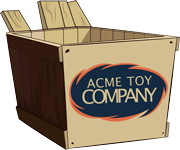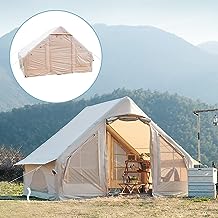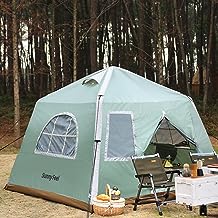The history of inflatable tents
Inflatable tents may seem like a modern invention, but their roots can be traced back to ancient times. The concept of using air to create a structure dates back thousands of years, with evidence of early civilizations utilizing animal skins or hides filled with air as makeshift shelters. However, it was in the mid-20th century that inflatable tents began to gain traction.
One of the earliest pioneers in inflatable tent technology was Otto Schick, a German engineer who patented the first inflatable tent design in 1968. Schick’s invention utilized an inner tube structure made of rubber, which could be inflated to create a sturdy and portable shelter.
This groundbreaking innovation marked the beginning of a new era for outdoor enthusiasts and adventurers. Inflatable tents continued to evolve throughout the years, with advancements in materials and construction techniques making them more durable and practical.
In the 1990s, advancements in manufacturing processes allowed for lighter yet robust fabrics such as nylon and polyester to be used in inflatable tent production. This led to increased popularity among campers, hikers, and festival-goers who sought lightweight and easy-to-pitch alternatives to traditional tents.
Today, inflatable tents have become increasingly sophisticated with the integration of advanced air beam technologies. These include high-pressure air beams made from reinforced materials like TPU (thermoplastic polyurethane) or PVC (polyvinyl chloride).
These materials provide exceptional strength while still maintaining flexibility for easy set-up and take-down. Additionally, innovations such as multiple inflation points enable users to erect these tents quickly without compromising stability.
showcases how this ingenious concept has evolved over time from primitive beginnings into cutting-edge designs that provide convenience without sacrificing durability. Understanding this historical context helps us appreciate the ingenuity behind these remarkable structures while also recognizing their practicality for modern-day adventurers seeking comfortable yet portable shelter options for their outdoor pursuits.
The different types of inflatable tents
When it comes to the world of inflatable tents, there is a vast array of options available to suit any camper’s needs. Let’s delve into the different types of inflatable tents that will surely elevate your camping experience. One popular type of inflatable tent is the dome tent.
These tents are known for their simple yet sturdy design. The shape resembles a dome, providing excellent stability in windy conditions.
Dome tents often have multiple air beams that you inflate individually, allowing for easy setup and customization. They come in various sizes, from cozy two-person models to spacious family-sized versions that can accommodate multiple campers comfortably.
The versatility and ease of use make dome tents an excellent choice for both beginners and seasoned campers alike. If you’re looking for a more unique camping experience, then geodesic inflatable tents might be right up your alley.
Inspired by nature’s own architectural wonders, these tents feature interconnected air beams that form intricate patterns on the exterior. Geodesic tents excel in providing superior stability and protection against harsh weather conditions such as heavy rain or strong winds.
Additionally, their spacious interiors make them ideal for larger groups or those who enjoy ample headroom while inside the tent. Whether you’re embarking on an adventurous expedition or simply seeking a luxurious camping retreat, geodesic inflatable tents are sure to leave a lasting impression.
Moving on to tunnel-style inflatable tents, they offer great space efficiency while maintaining durability and ease of setup. These tents feature long air beams running parallel to each other, creating a tunnel-like structure that maximizes interior space without compromising stability.
Tunnel-style inflatable tents are often designed with separate sleeping compartments and living areas, giving campers privacy and convenience during their outdoor escapades. With their lightweight construction and reliable performance in various weather conditions, these versatile shelters are particularly popular among backpackers and solo adventurers seeking comfort without sacrificing portability.
Whether you prefer the simplicity of dome tents or desire the structural elegance of geodesic or tunnel-style tents, there is an inflatable tent to suit every camper’s taste and requirements. Exploring the different types of inflatable tents will not only inspire your camping adventures but also ensure you select a shelter that perfectly complements your outdoor lifestyle.
The benefits of inflatable tents
Inflatable tents have gained immense popularity among outdoor enthusiasts, camping aficionados, and festival-goers for several compelling reasons. One of the key benefits of inflatable tents is their remarkable ease of setup.
Traditional tents often require a complex web of poles and ropes to be meticulously arranged and secured. In contrast, inflatable tents can be pitched within minutes with the help of an air pump.
Simply inflate the structure, and voila! Your cozy home away from home is ready to welcome you.
Another advantage of inflatable tents lies in their superior stability and durability. The sturdy construction materials used in these tents ensure that they can withstand varying weather conditions with ease.
Modern inflatable tents are often designed with reinforced fabrics that are not only resistant to tears but also provide excellent insulation against cold or heat. Moreover, their robust structures enable them to withstand strong winds more effectively than traditional counterparts, thanks to well-engineered air chambers that evenly distribute pressure throughout the tent.
Additionally, inflatable tents offer increased versatility compared to conventional options. Many models feature customizable layouts that allow for separate rooms or dividers within the same tent.
This flexibility proves particularly beneficial for families or larger groups who may desire some privacy or prefer designated spaces for sleeping, storage, or socializing. Furthermore, when it comes to portability, inflatable tents excel in providing a lightweight alternative without compromising on space or comfort.
The deflation process is quick and hassle-free as well – simply release the air valves and watch your tent shrink into a compact size that fits neatly into its carrying bag. But certainly not leastly (if I may indulge in a little wordplay), maintenance is effortlessly easy with inflatable tents!
Unlike traditional pole-based options where poles can get lost or damaged over time through wear and tear, repairing an inflatable tent typically involves patching up a small hole using a repair kit – no need to purchase new parts or worry about finding replacements. Inflatable tents offer an array of benefits that make them a convenient, practical, and reliable choice for outdoor enthusiasts.
From their quick and easy setup to their durability, versatility, and portability, these tents are a testament to modern engineering’s ability to enhance our camping experiences. So the next time you plan an adventure in the great outdoors or gear up for a festival under the stars, consider embracing the wonderful world of inflatable tents – your home away from home awaits!
The drawbacks of inflatable tents
When it comes to inflatable tents, it’s important to consider both the positives and the negatives. While inflatable tents have their fair share of advantages, there are a few drawbacks that you should keep in mind before making your purchase. One of the main drawbacks of inflatable tents is their vulnerability to punctures.
Unlike traditional tents that are made from sturdy materials like canvas or nylon, inflatable tents are constructed using more delicate materials such as PVC or TPU. While these materials are durable and designed to withstand normal wear and tear, they can be more susceptible to punctures from sharp objects like rocks or branches.
This means you need to exercise caution when selecting your camping spot and be mindful of any potential hazards that could damage your tent. Another drawback of inflatable tents is their reliance on air pumps for setup.
In order to inflate the tent, you will need a pump, either manual or electric, which can add an extra piece of equipment to carry around. If you forget to bring the pump or it malfunctions, setting up your tent can become quite challenging.
Additionally, inflating an entire tent takes time and effort compared to the quicker setup process of traditional tents that require only assembling poles and attaching fabric. This aspect can be particularly frustrating if you arrive at your campsite exhausted after a long journey and just want to get settled in quickly.
Despite these drawbacks, it’s worth noting that modern inflatable tents have come a long way in terms of durability and ease of use. Many manufacturers now offer puncture-resistant materials and reinforced seams for added resilience against potential damages.
Furthermore, some higher-end models even come with built-in pumps that make setup a breeze. By considering these limitations and taking precautions such as choosing suitable camping spots away from sharp objects and ensuring you have a reliable pump at hand, you can still enjoy all the benefits that an inflatable tent has to offer without being hindered by their minor drawbacks.
How to choose the right inflatable tent for your needs
When it comes to choosing the right inflatable tent for your needs, there are several factors to consider. First and foremost, you need to determine the size of the tent that will accommodate your camping party comfortably. Think about how many people will be sleeping in the tent and whether you’ll need additional space for storing gear or other belongings.
It’s always a good idea to opt for a slightly larger tent than you think you’ll need, as this provides more room to move around and ensures everyone has enough personal space. Next, consider the design and layout of the inflatable tent.
Some tents feature separate sleeping compartments or multiple entry points, which can be advantageous if you prefer more privacy or want easier access in and out of the tent during nighttime bathroom breaks. Additionally, pay attention to the height and shape of the tent.
A higher ceiling can make a big difference in terms of comfort, especially if you plan on spending extended periods inside during inclement weather. Durability is another crucial factor when selecting an inflatable tent.
Look for tents made from high-quality materials that are resistant to tears, punctures, and UV damage. Reinforced seams are also essential for ensuring longevity.
Consider whether you’ll be using your inflatable tent primarily for camping trips in mild weather conditions or if it needs to withstand more extreme elements such as heavy rain or strong winds. Opting for a tent with a higher waterproof rating and robust construction will give you peace of mind knowing that it can handle whatever nature throws at it.
Don’t forget about convenience features such as ease of inflation and deflation, as well as portability. Some inflatable tents come with built-in air pumps or have innovative valve systems that make setup quick and hassle-free.
Additionally, look for tents that come with carrying bags or backpacks for easy transportation – this is particularly important if you plan on backpacking or hiking with your inflatable tent. By considering these factors – size, design/layout, durability, and convenience – you can narrow down your options and choose the right inflatable tent that will perfectly suit your needs, providing you with a comfortable and enjoyable camping experience.
Tips for setting up and using an inflatable tent
Setting up and using an inflatable tent can be a breeze if you follow a few handy tips and tricks. First and foremost, before setting up your tent, make sure you choose a suitable spot. Look for a flat and even surface, free from any sharp rocks or branches that could potentially puncture the tent’s material.
It’s also important to clear the area of any debris or objects that might hinder the inflation process. Once you’ve found the perfect spot, lay out the tent on the ground and ensure all the zippers are closed.
Begin by inflating each individual air chamber of the tent using either an electric pump or a manual foot pump. Start with the main chamber and work your way through each section until they are all inflated evenly.
Take your time during this step to ensure that each chamber is fully inflated to its recommended pressure level. After inflating all chambers, go around the perimeter of the tent and make sure all guy lines are properly secured.
These lines help stabilize the structure in windy conditions, so it’s essential not to overlook them. Once everything is secure, take a step back and admire your fully erected inflatable tent!
Now it’s time to move on to using it. When you’re inside your cozy haven, keep in mind that inflatable tents require some extra care compared to traditional tents.
Be mindful of sharp objects such as knives or keys that could accidentally cause damage when coming into contact with the material. Avoid dragging heavy items across the floor as this can create unnecessary stress on seams and inflate air chambers.
Furthermore, it’s crucial to keep dirt and moisture out of your inflatable abode by utilizing ground sheets or tarps both inside and outside of your tent. This added protection helps prevent wear and tear while maintaining a clean living space.
Additionally, ensure proper ventilation by opening windows or vents when weather conditions allow; this will aid in preventing condensation buildup inside your temporary sanctuary. By following these tips for setting up and using an inflatable tent, you’ll be well on your way to a hassle-free camping experience.
Remember, taking a little extra care and being mindful of your surroundings will ensure that your tent remains in top-notch condition for many adventures to come. So go ahead, pitch that inflatable tent with confidence and enjoy the outdoors like never before!
Conclusion
Inflatable tents offer a multitude of advantages that make them a fantastic choice for outdoor enthusiasts. Their versatility, quick setup time, and durability make them ideal for various camping scenarios. Whether you’re a seasoned backpacker or a weekend warrior, investing in an inflatable tent can greatly enhance your outdoor experiences.
One of the key benefits of inflatable tents is their portability. They can be easily deflated and packed into a compact bag, making them convenient to carry on hiking trips or road adventures.
Additionally, their lightweight design ensures that they won’t weigh you down during your journey. This portability factor also makes them an excellent option for those who enjoy attending music festivals or other outdoor events where camping is involved.
Moreover, the durability of inflatable tents should not be underestimated. Constructed with robust materials such as high-quality polyvinyl chloride (PVC) fabric and reinforced seams, these tents are built to withstand various weather conditions and rough terrains.
They provide excellent resistance against wind, rain, and even UV rays, ensuring that you stay safe and comfortable within your shelter. Embracing the world of inflatable tents opens up a whole new realm of possibilities for adventurers and nature lovers alike.
By selecting the right inflatable tent based on your needs and preferences, you can create unforgettable memories in the great outdoors without compromising on comfort or convenience. So go ahead – take the leap into the exciting world of inflatable tents and let them be your trusty sidekick as you embark on countless thrilling adventures ahead!




